Слайд 2Английский язык имеет сильную тенденцию к различного рода сокращениям слов. В
английском словарном составе большое место занимают короткие, односложные и двусложные слова, а более длинные воспринимаются как нечто инородное.

Слайд 3An abbreviation (from Latin brevis, meaning short) is a shortened form
of a word or phrase. Usually, but not always, it consists of a letter or group of letters taken from the word or phrase. For example, the word abbreviation can itself be represented by the abbreviation abbr., abbrv. or abbrev.
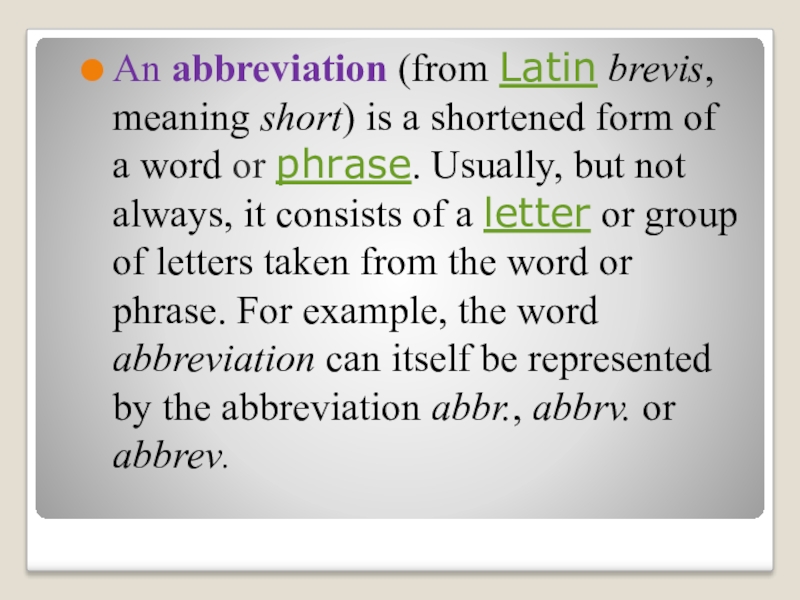
Слайд 4types of cuts
(типы сокращений)
graphical
lexical
(графические) (лексические)
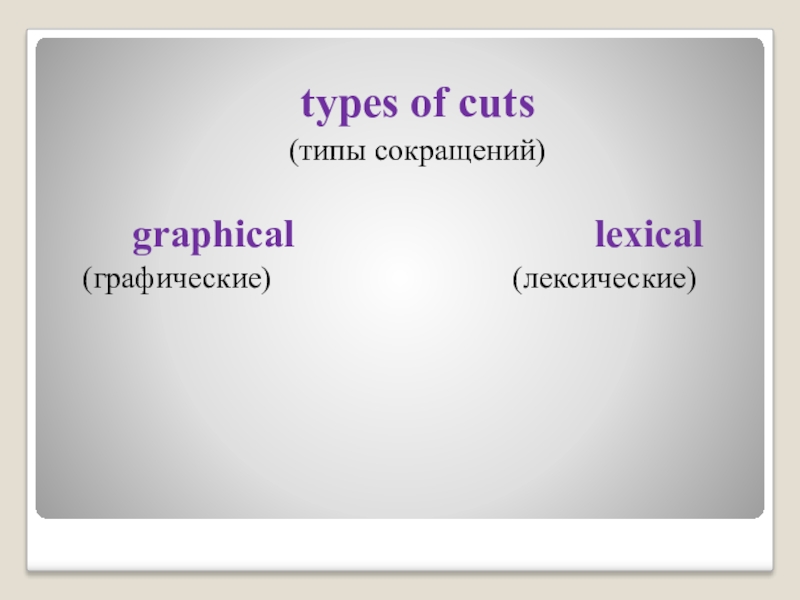
Слайд 5 Graphical abbreviations are the result of shortening of words and
word-groups only in written speech while orally the corresponding full forms are used. They are used for the economy of space and effort in writing.
e.g. – for example,
a.m. –in the morning (ante meridiem),
p.m. – in the afternoon,
No — number (numero), i.e. – that is (id est).
P.S. — post script
Etc – et cetera
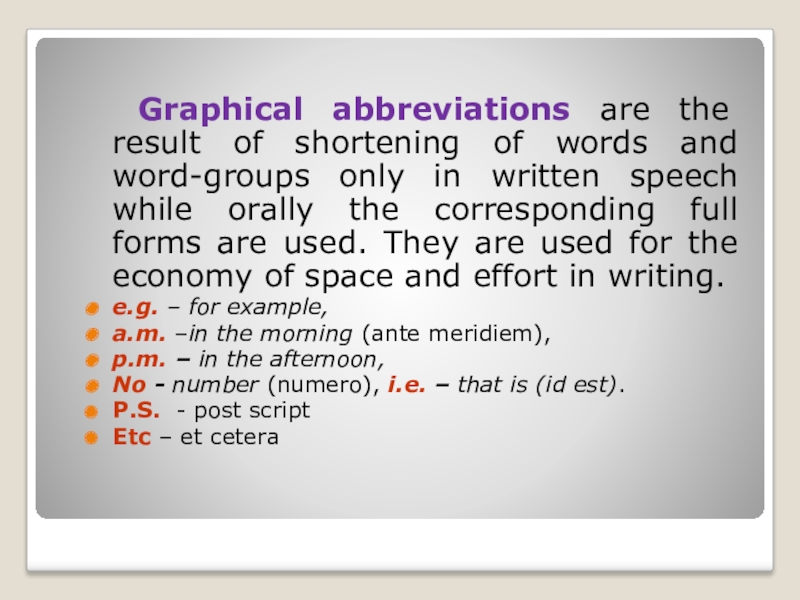
Слайд 6
Abbreviation types
Initialism
Acronym
Truncation
Clipped
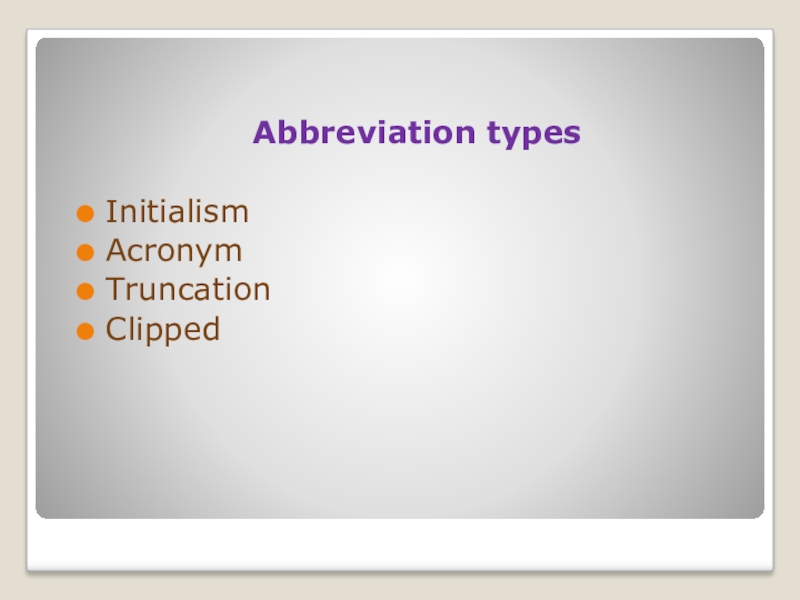
Слайд 7Initialism – Also called alphabetism, this is a group of letters,
each pronounced separately, used as an abbreviation for a name or expression.
Examples include:
UK (United Kingdom) – Соединенное Королевство;
the USA (the United States of America) — США;
AB (Activity Book) – рабочая тетрадь;
WB (Work Book)- рабочая тетрадь;
SB (Student’s Book) — учебник;
BBC (British Broadcasting Corporation) – Британская вещательная корпорация;
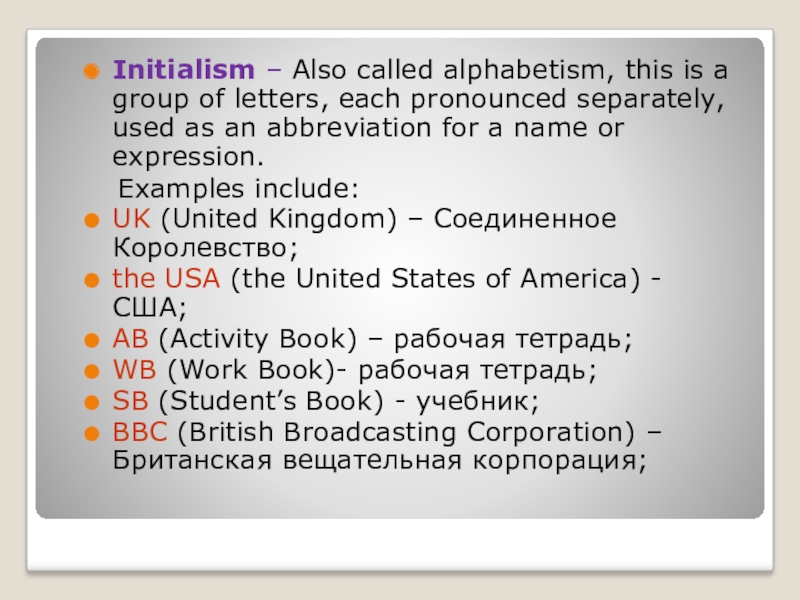
Слайд 8 Acronym – this forms a word using the
initial parts or first letters of a name.
For example:
UNESCO (United Nations Education, Scientific, Cultural Organization) – Организация Объединённых наций по вопросам образования, науки и культуры, ЮНЕСКО;
OPEC (Oil Producing European Countries) — ОПЕК,
SAM (Secure Access Management) — управление защищенным доступом;
and are all acronyms that take the first letter from each word to form a new word.
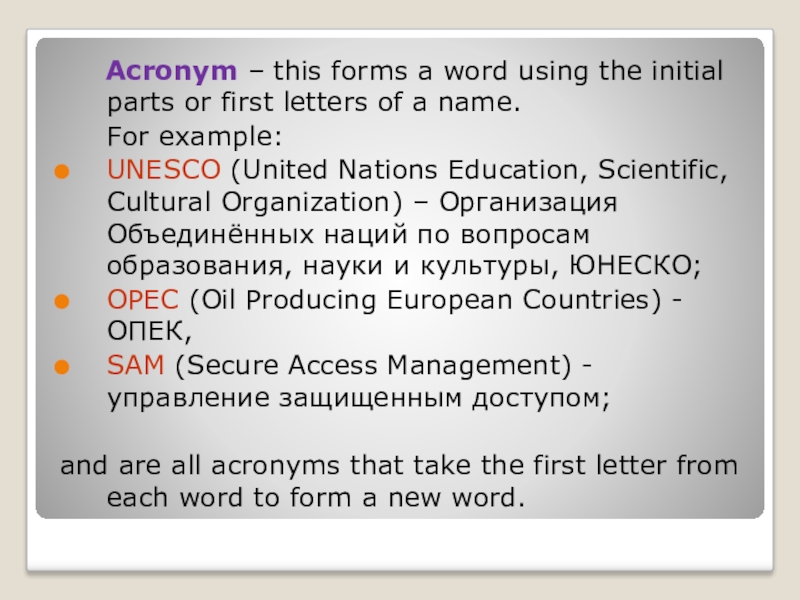
Слайд 9WAP (Wireless Application Protocol) – протокол мобильной интерактивной связи с Интернетом;
UFO
(unidentified flying object) — неопознанный летающий объект, НЛО;
UNO (United Nations Organization) — Организация Объединённых Наций, ООН.
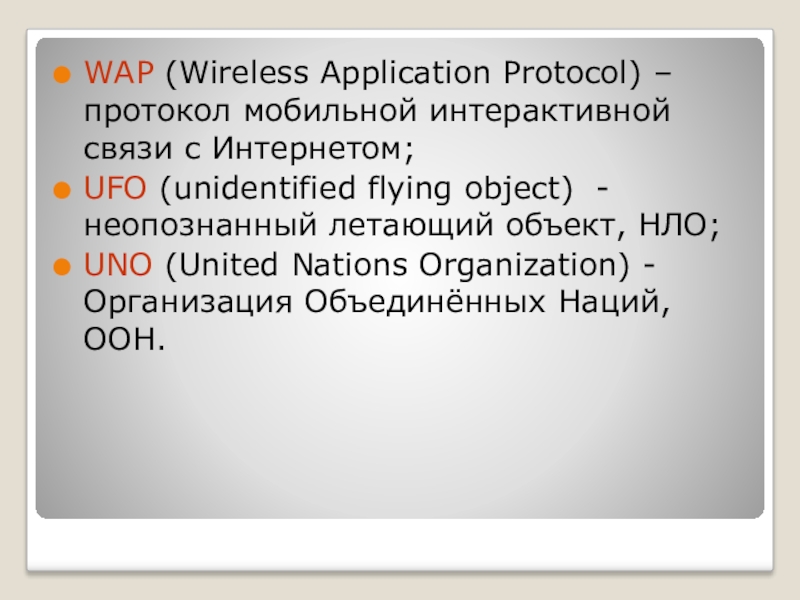
Слайд 10
Truncation – This type of abbreviation consists only of the first
part of a word. These are most often used when referring to proper titles such as months of the year or days of the week, e.g.,
Tues. = Tuesday;
Dec. = December;
Minn. = Minnesota;
Eur = Europe, European
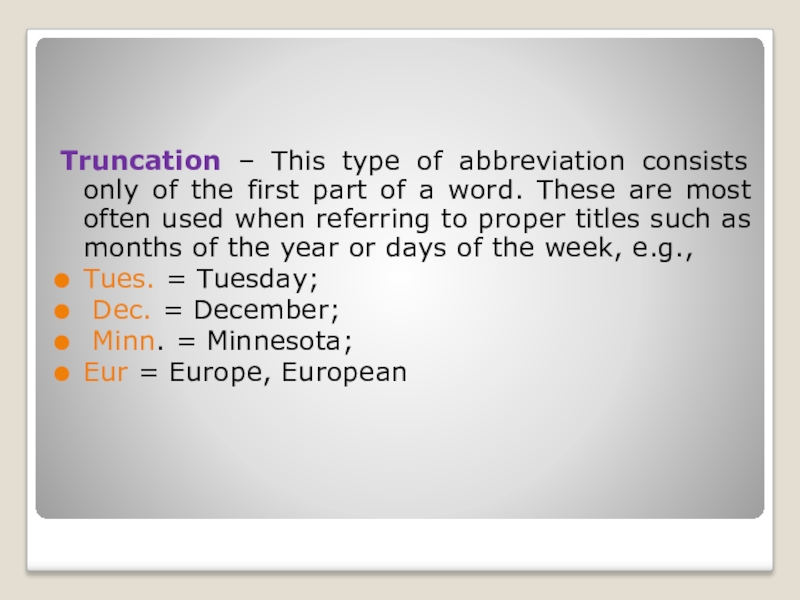
Слайд 11Clipped – similar to truncation in that you are using a
part of the word to form the abbreviation, but in this case you’re using either the middle or end. Common clipped abbreviations include
phone (telephone)
fridge (refrigerator).
labware (laboratory ware) – лабораторное оборудование;
T-shirt (tee-shirt) – футболка;
commode (communications mode) – режим связи;
A-bomb (atomic bomb) — «атомная бомба»;
e-mail (electronic mail) – электронная почта.
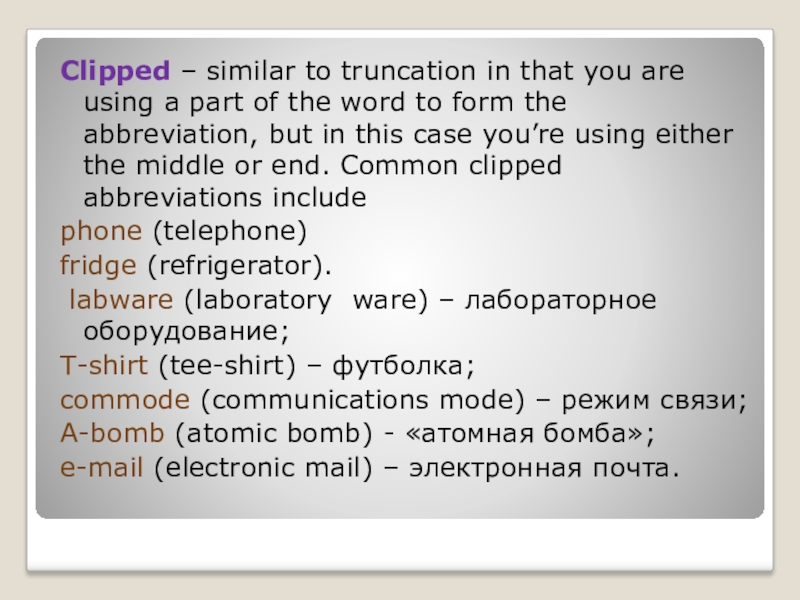
Слайд 12Commonly used abbreviations
BBC (British Broadcasting Corporation) Би-би-си, Британская вещательная корпорация;
CD (compact
disc) компакт-диск;
CDROM (compact disk read-only memory) – компакт-диск без возможности перезаписи;
DJ ( disc jockey) ди-джей;
DVD (Digital Video Disk) цифровой видеодиск;
SMS (Short Message Service) — служба коротких сообщений;
SOS (Save our souls) — радиосигнал бедствия, «спасите наши души»;
TV ( television) – телевидение;
USB (Universal Serial Bus) универсальная последовательная шина;
VIP (very important person) ВИП, очень важная персона, особо важная персона
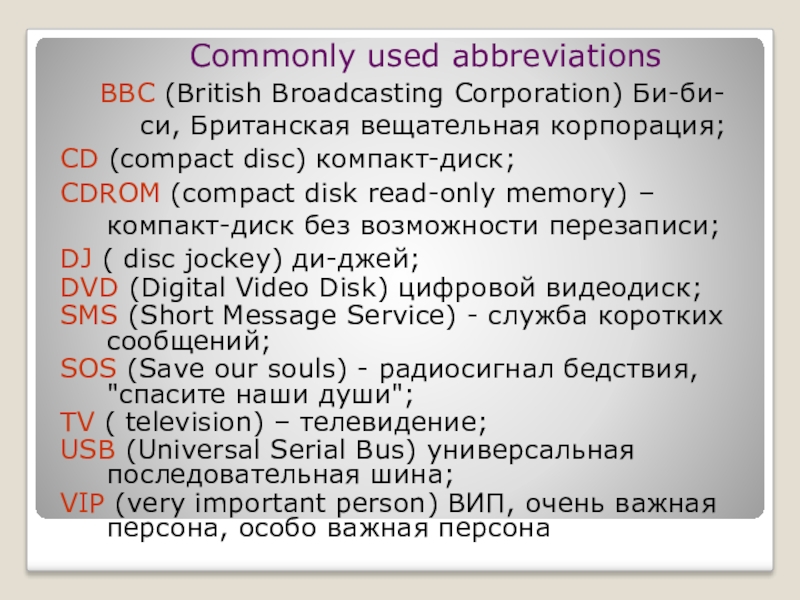
Слайд 13A unique language in text messages
KIT (Keep in touch) – оставайся
на связи
AUOK? (Are you Ok?) – ты в порядке?
W4u (Waiting for you) – жду тебя
HRU? (How are you?) – Как дела?
Cm (Call me) – позвони мне
T2ul (Talk to you later) – поговорим позже
PCM (Please call me) – позвони мне, пожалуйста
NP (no problem) – без проблем
BBS (Be back soon) – буду скоро (скоро вернусь)
Сu (See you) – увидимся
IM (I am) F2Т (Free to talk) – я могу разговаривать
T2Go (Time to Go) – пора идти
ILBL8 (I’ll be late) – Я опоздаю!

Слайд 14Tty to explain the abbreviations:
2MORO
04U
T2ul
T2Go
Thx
SRY
SMS
WC
BKSAiD
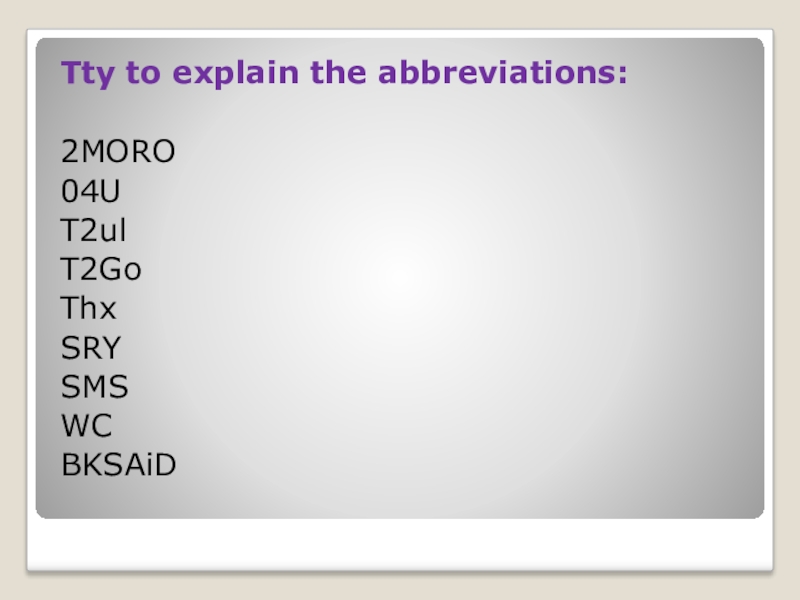
Слайд 15
Thk U 4 d lesson ,
Im glad 2 MEt U
&
wsh U evry sukses.

You know the world of English
is a fun and exciting place to be.
I’m so glad you could join me for another lesson.
In this lesson
we will take a look at what happens when we want to make a long word or a group
of words into a smaller and easier to remember form or as it is commonly known
— Abbreviation.
The first type of abbreviation
is initial abbreviation, where the first letter of each word is used to form the final abbreviation. They are read as individual letters.
For example, the abbreviation
VIP is formed from using the letters from — Very
Important Person. So VIP is the result. It is easier
to remember and also much easier to say.
So here
we go with some other examples of initial abbreviations:
LOL – Laugh Out Loud
UFO – Unidentified Flying
Object
GB – Great Britain
BMW – Bavarian Motor Works
FBI – Federal Bureau of
Investigation
WWW – World Wide Web
MTV – Music Television
SMS – Short Message Service
PC – Personal Computer
FAQ – Frequently Asked
Questions
DND – Do Not Disturb
Secondly, there is a type of
abbreviation we call Acronym. In this case the
first letters from each word actually form another word.
For example, LASER. The word is made up from the first letters of Light Application by
Stimulated Emission of Radiation. Here you will notice that not all of
the first letters are used. Often the word “and” is
left out of the formula. This rule mostly applies to conjunctions and
prepositions.
Here are some more examples of
acronyms.
AIDS – Acquired Immune
Deficiency Syndrome
NATO – North Atlantic Treaty
Organization
WHO – the World Health
Organization
JPEG – Joint Photographic
Experts Group
NASA – National Aeronautical
and Space Administration
UNESCO – United Nations
Educational, Scientific and Cultural Organization
scuba — self-contained underwater breathing apparatus
FIFA — The Federation of
International Football Associations
PIN – Personal Identity Number
Some English words are used in a shortened form in informal situations — Clipping
The beginning is left.
ad = advertisement
cable = cablegram
doc = doctor
exam = examination
fax = facsimile
gas = gasoline
gym = gymnastics
pub = public house
pop = popular music
The middle part is left.
flu = influenza
fridge = refrigerator
The final part is left.
chute = parachute
coon = raccoon
gator = alligator
phone = telephone
Clipping is common when we use
personal names:
|
Timothy |
Tim |
|
Elizabeth |
Betty, Liz |
|
Pamela |
Pam |
|
James |
Jim, Jimmy |
|
Susan |
Sue |
|
Katherine |
Kate |
Some abbreviations have only
written forms. They are pronounced as the full word.
Mr –
Mister
Dr — Doctor
i.e. – that is
Mrs –
Missis St –
Saint
St — street
Ms — Miss
e.g – for example No –
Number
km –
kilometer(s)
etc. – and so on
When we want to make a word or
phrase shorter we abbreviate it by omission of
internal letters which are replaced by an apostrophe. This is
called contraction.
I am = I’m
He is = He’s
He does not = He doesn’t
I must not= I mustn’t
They have = They’ve
With the popularity of
Facebook, Twitter, VK, emails, online gaming services, mobile phone text
messaging (SMS) came emergency in a new texting language.
The main principle of SMS —
language is the maximum information in the minimum amount of keystrokes.
There are four main rules of
forming sms-shortening.
1. One letter or number
substitute the whole word, for example:
be — b; ate — 8; see — c; for — 4; are — r; to / too —
2; you — u; why — y; your / you are — ur.
2. One letter or number
substitute the syllable, for example:
great — gr8; later — l8r; before — b4; today — 2day; no one
— NO1; anyone — NE1; forever — 4eva.
3. Changing the value of
symbols, for example:
ss — $; oo -%;-orr— oz; sorry
— soz; tomorrow — 2moro; thanks — TX; today — 2dA; says — sez; because — coz or
bcoz; please — plz;
4. Omitting of letters and
punctuation marks:
text – txt, with — w / t (a);
something — s / t; boyfriend — b / f; homework — h / w; class work — c / w,
between — btw; speak — SPK; people — PPL; please — PLS; friend — frnd; message
— msg, probably — prbly
Here are some other examples
of modern text lingo:
WU? — What’s
Up?
TTY — talk to you later
BTW — by the way
IMHO — in my honest opinion
HAND — have a nice day
OMG – Oh my God
CU — See You
NP — No problem or Noisy
parents
PLS — Please
RUOK — Are You OK?
ZZZ — Sleeping
HBD — Happy Birthday!
BRB – Be right back
ILY – I love you
TGIF – Thanks god it’s Friday
IDK – I don’t
know
2MI — Too much information
REHI — Hello Again (re-Hi!)
OTF — On the Floor
HHOK — Ha Ha Only Kidding
HTH — Hope This Helps
TAFN — That’s
all for now.
Read the text messages below
and try to decode them.
1. I hope I will CU L8R. MayB
2mrw?
OK! Hand.
I hope I will see you later.
Maybe tomorrow?
OK! Have a nice day.
2. Had a gr8 time tnx 4 ur present. C u 2mrwJ
Had a great time. Thanks for
your present. See you tomorrowJ
3. Y did ur
bro send me that msg?
IDK.
Why did your brother send me
that message?
I don’t
know.
4. 2B or not 2B?
To be or not to be?
5. hi
m8. ruok? i soz i 4gt 2 cal u
lst nyt. y dnt we go c film 2moz
Hi, mate. Are you okay? I am
sorry that I forgot to call you last night. Why don’t
we go and see film tonight?
Abbreviations make our life
easier.
There are hundreds of
abbreviations around and new ones are constantly being
created. You could even invent your own shortened phrase.
However, when using them, don’t overdo it.
TAFN. TNX Can you guess what
it stands for?
That’s
all for now. Thanks
-
EM
-
Articles
-
Style
-
Abbreviations
Summary
An abbreviation is the shortened form of a term. It may comprise the first letters of the words of a phrase or be the contracted form of a word.
Examples
- USA, UK, EU, GDPR, NBA, TIN, CEO, ATM, FYI, WHO, PDA, DNS
- e.g., i.e., a.m., p.m., etc., et al.
- kg, g, ms, mph, dc, bhp, rpm, kmps
- Dr., Rev., Mr., Dec., Inc., Corp., Jr., Sr.
Abbreviations are useful when space is limited. Also use them to avoid repeating a lengthy term multiple times in a document. In formal writing, explain an abbreviation by providing its full form at first use.
Example
- Such solar-powered devices (SPDs) are now common in most households.
You don’t need to explain a term that is generally used in its abbreviated form or is listed as a noun in the dictionary.
Examples
- The UK has left the EU.
- Here is a list of FAQs.
What is an abbreviation?
An abbreviation is the shortened form of a term, often formed using the first letter of every word in a multi-word phrase. An abbreviation can also simply be the contracted form of a single word.
Examples
- USA
- UK
- EU
- UN
- FBI
- NASA
- NATO
- PC
- DOS
- CMS
- SEO
- SSN
- HRH
- CEO
- VP
- MD
- BCE
- Mt.
- St.
- Dr.
- Mr.
- Prof.
- Gen.
- Pres.
- Jan.
- Sun.
Abbreviations are common in both formal and informal writing.
Example
- Dr. Strange and Capt. Nemo attended the UN conference on DNA research held in the UK on Feb. 1, 2039.
Many terms are better known by their abbreviated than their full forms.
Examples
- DNA
- GPS
- HTML
- URL
- DNR
- CD
- DVD
- VPN
- JPEG
- CEO
- ATM
- PhD
- NASA
- OPEC
- NATO
- UNICEF
- GMT
Types of abbreviations
An abbreviation can be an initialism, an acronym, a contraction, or other shortened form. An initialism comprises the first letters of the words in a term.
Examples
- CEO: chief executive officer
- BA: business analyst
- USA: United States of America
- UK: United Kingdom
- GDPR: General Data Protection Regulation
- CIA: Central Intelligence Agency
- UN: United Nations
- TIL: today I learned
- FYI: for your information
- e.g.: exempli gratia
- aka: also known as
mph: miles per hour
An acronym is an abbreviation pronounced as a word.
Examples
- NATO: North Atlantic Treaty Organization
pronounced NAY-toh, not N-A-T-O
- NASA: National Aeronautics and Space Administration
- OPEC: Organization of the Petroleum Exporting Countries
- AWOL: absent without leave
With usage, some acronyms become words in their own right.
Examples
- scuba: self-contained underwater breathing apparatus
- laser: light amplification by stimulated emission of radiation
- sonar: sound navigation and ranging
- radar: radio detection and ranging
Tip
Only abbreviations pronounced as words are acronyms, like UNESCO and NAFTA. Others, like USA and UN are initialisms.
Abbreviations may also be contractions and other shortened forms.
Examples
- Jan.: January
- Mr.: Mister
- Dr.: Doctor
- Rev.: Reverend
- Inc.: Incorporated
- vol.: volume
- ed.: editor/edited
Note
Contractions include words such as couldn’t and don’t, but these are not generally categorized as abbreviations.
When to use
Use abbreviations to avoid repeating long phrases and terms in a document. Abbreviations also help convey information easily when space is limited (e.g., in charts and figures).
Example
- The computerized self-driven long-haul submarine (CSLS) is now an energy-friendly way to cross the Pacific. In this paper, we investigate whether the increased use of CSLSs has resulted in environmental gains and lower airfares.
Also use abbreviations when your readers would be more familiar with the abbreviated than the full form.
Examples
- ATMs will then meet the same fate as other relics of the past, like phone booths and internet cafés.
- Minerva Dash is our new CEO.
- Anita has a PhD in mathematics.
How to use correctly
In general, explain an abbreviation at first use by providing its full form.
Examples
- An all-terrain vehicle (ATV) is like a motorcycle with extra wheels.
- The UN (United Nations) aims to find shared solutions for humanity.
- The EU (European Union) has 27 member states.
- The British Academy of Film and Television Arts, or BAFTA, is an independent arts organization.
Tip
In an academic paper or report, consider adding a glossary or list of abbreviations after the index.
Abbreviated forms listed as nouns rather than as abbreviations in the dictionary need not be explained.
Examples
- DNA
- GPS
- CEO
- UFO
- HTML
- JPEG
- TV
- ATM
- DVD
In formal writing, avoid starting a sentence with an abbreviation.
Example
- Poor: U.S. officials arrived in Paris this morning.
Better: United States officials arrived in Paris this morning.
But note that acronyms (abbreviations pronounced as words) and standard contractions are fine in this position.
Examples
- NASA scientists have discovered a new planet.
- Dr. Dash isn’t who she claims to be.
Abbreviations with two or more capital letters generally don’t require a period.
Examples
- USA
- EU
- UK
- UN
- WHO
- CDC
- NATO
- NAFTA
- PC
- PM
- VP
- CEO
- MBA
- PhD
- NGO
- TBD
- FYI
- TRP
- PIN
- OTP
- ROI
- CPR
- COVID
- HIV
Many lowercase abbreviations take internal periods, but periods are generally omitted in scientific and technical abbreviations and abbreviated SI units.
Examples
- e.g., i.e., etc., a.m., p.m.
- bhp, rpm, mph, km, kmps, g, mg
but
To form the plural of an abbreviation, simply add s (or es) without an apostrophe.
Examples
- URLs
- VPs
- PhDs
- CMSs (or CMSes)
To pluralize a contraction, add s and move the period to the end.
Examples
- Drs. Rongen and Vimes
- Profs. Diaz and Johnson
- Mss. (or Mses.) Fatima and Greene
Tip
The plural of Mr. is Messrs., now seen mainly in legal texts.
Use of the indefinite article (a/an) depends on how the abbreviation is pronounced. If it starts with a consonant sound, use a if it starts with a vowel sound, use an.
Examples
- an ATM but a UFO
- a CEO but an MD
The article the is omitted with acronyms of proper nouns (since they are pronounced as words), even if it would be used with the full form. The is still generally used with initialisms (of which the letters are individually pronounced).
Examples
TheUNICEF is providing food and technical support to fighttheCOVID in Lebanon.- The UK has trade agreements and deals with more than 60 countries.
but
Содержание:
INTRODUCTION
Abbreviation processes in modern English are very active, due primarily to the desire to make thought as capacious as possible. Abbreviations are characteristic not only for scientific discourse, in which a significant number of concepts are expressed through abbreviations, but also for colloquial speech and journalism, where they have their own characteristics of use.
The relevance of this study is due to the lingering interest of linguists to abbreviation processes and the problem of translation, which has recently received a lot of attention in connection with the development of translation computer programs, their improvement and the development of new terminological dictionaries and educational translation books.
The novelty of this study is determined by a thorough and detailed analysis of translation techniques applied to various types of business correspondence, which is a new step towards achieving high-quality translation of abbreviations in various functional styles.
This paperwork examines the problem of translating abbreviations used in fiction, journalism, scientific, characterizing financial and economic texts and business correspondence, a question that is not well studied and deserves in connection with various interpretations and ambiguities of abbreviations presented in two languages, which requires close attention translation.
The emergence of a new abbreviation word is the result of a struggle between two trends: the tendency of language development and the tendency of its preservation. In order to more adequately reflect, reproduce and consolidate new ideas and concepts, language in general and vocabulary in particular are forced
rebuild, differentiate, generate new lexical units.
In the formation of new concepts, morphemes existing in this language, or morphemes and even words borrowed from other languages, can be used, or, which is much less common nowhere and never before existed vocabulary.
Abbreviations of words and phrases to several letters and one letter have recently become increasingly widespread due to the general tendency of the language to save money on the expression of lexical meaning [20]. The constantly growing pace of life, the rapid increase in the flow of information lead to the formation of a
3
large number of reductions of various kinds. The modern era is associated with the emergence of new phenomena in art, technology, changes in all areas of human activity. In this regard, there are new concepts, the designation of which, as a rule, is associated with phrases, used in the form of abbreviations to the initial letter of each individual lexical component, and not using the original phrase in full form.
Since the materials of this study are abbreviations, we focus on the features of various discourses that affect the specifics of their use and translation in various kinds of texts.
The necessary theoretical foundation for a multi-aspect study of the nature of stylistic phenomena that affect the abbreviation translation features is created by the achievements of domestic and foreign scholars in the field of general linguistics (А.Вежбицкая, П.Н.Денисов), stylistics (И.В.Арнольд, И.Р. Гальперин), and translation theories (Л.С. Бархударов, В.Н. Комиссаров, Т.А. Казакова).
The purpose of this work is to study the specifics of the reflection in translation from English into Russian of such structurally important translation units as abbreviations.
Drawing attention to the many works devoted to the problem of the lexical meaning of the word and are given in the bibliography, we formulate the tasks of the work as follows:
• consider in general terms the stylistic features of the use of abbreviations in colloquial speech, presented in fiction, journalism, scientific, characterization of financial and economic texts and business correspondence,
• describe the features and different types of abbreviations: slang, common vocabulary, terms,
• find out the features of the translation of abbreviations in fiction, journalism, scientific, characterization of financial and economic texts and business correspondence paying attention to the reasons for the use of specific translation techniques.
The practical significance of the work is that the results of the study and the proposed translation solutions can be used in theoretical and practical classes in lexicology, morphology and translation studies.
The work includes an introduction, two chapters, conclusion and list of references.
4
CHAPTER 1. USE OF ABBREVIATIONS AND TRANSLATION PROBLEM
1.1. Classification of abbreviations: slang, common vocabulary, terms.
The abbreviation of phrases, considered by a number of lexicologists as a lexical abbreviation of the phrases [Елисеева 2003], is used quite often when forming new words in English to express meaning in the most capacious form:
VIP = very important person – оченьважныйчеловек
PRO = publicrelationsofficer – сотрудникпосвязям с общественностью
However, the abbreviation is represented more frequently in various terminologies. When shortening words and phrases, in most cases only the first letter of each word is used [Ахманова 2002: 487]. Most often abbreviations are subject to scientific and technical terms, as well as the names of social groups and organizations. Usually abbreviations are used more often than full forms of names. For example, in the field of banking, mathematics and medicine, the following initial abbreviations can be called:
BB = bill book – книгасчетов
NZ (Non Zero)неноль
ARD = acuterespiratorydisease острое респираторное заболевание
If there is an official word in the composition of the phrase (most often the union and), this word is either omitted completely or remains [Ахманова 2002]. In some cases, the abbreviation is not fully implemented:
BandPcost = bidandproposalcost–ценазаявкиипредложения
C and F = cost and freight – стоимостьифрахт
C and I = cost and insurance – стоимостьистраховка
C and F, CAF = cost and freight – стоимостьифрахт
All the abbreviations listed are scientific and business terminology.
5
The abbreviations used in journalism are primarily the names of various organizations. Many of which are now part of the common vocabulary:
NASA (NationalAeronauticsandSpaceAdministration); — НАСА (Национальное управление по аэронавтике и исследованию космического пространства);
NATO (NorthAtlanticTreatyOrganization) — НАТО (Организация Североатлантического договора);
OPEC (Organization of Petroleum-Exporting Countries) — ОПЕК (Организациястран-экспортеровнефти).
In addition, slang abbreviations are closely related to the common vocabulary:
VIP = very important person;
PRO = public relations officer …
“In commercial letters written in English,” says E.E. Izrailevich, — there is a large number of standard expressions used to confirm the receipt of business letters, to express a request, when reporting on the sending of documents, catalogs and samples, when referring to documents, etc. Among these stereotypical expressions there are fancy turns and expressions characteristic of commercial jargon”[Израилевич 1992: 7]. Many such cliche and terms are often used in the form of abbreviations:
GDP or gdp — gross domestic product — ВВПилиВВП — валовойвнутреннийпродукт;
CV — curriculumvitae – биографическиеданные
IMF — International Monetary Fund — МВФ — Международныйвалютныйфонд;
CEOs — chiefexecutiveofficers — генеральныедиректора
CFOs — chief financial officers — финансовыедиректора;
COOs — chief operating officers; — главныеоперационныедиректора;
rep — representative — представитель
Among the usual abbreviations, acronyms should also be distinguished, that is, initial abbreviations, pronounced as words and having homonyms in the form of words in a given language. This group of initial cuts began to develop in the twenties of the twentieth century and became widespread after the Second World War [Алексеев 2010]. Acronyms include the following initial abbreviations:
6
AIDS (AcquiredImmuneDeficiencySyndrome) — СПИД (синдромприобретенногоиммунодефицита);
BASIC (Beginners’ All-purpose Symbolic Instruction Code) -Бейсик(языкпрограммирования);
In recent years, a new structural type of initial abbreviations of this type has appeared, at the end of which the suffix -y / -ie was added to the initial abbreviation or was the initial abbreviation of the last component of the phrase, for example:
JUPPIE (Japanese Urban Professional Person) — яппи, японскогопроисхождения;
MUPPIE (Middle-aged Urban Professional Person) — городскойжительсреднихлетсвободнойпрофессии (юрист, врач, преподавательит.п.);
as well as educational types:
DINKY (DoubleIncomeNoKidsYet) — семья, гдеобасупругаработают, адетейпоканет;
NELKY (NoIncomeLotsofKids) — безработныесбольшойсемьей;
CARD (CampaignAgainstRacialDiscrimination) — движениепротиврасовойдискриминации;
CLASS (Computer-basedLaboratoryforAutomatedSchoolSystems) — класспрограммированногообучениясприменениемэлектронно-вычислительныхустройств;
NOW (National Organization for Women) — Национальнаяорганизацияженщин;
SAD (Seasonal Affective Disorder) — хандравзимниемесяцы;
SALT (StrategicArmsLimitationTalks) — переговорыпоограничениюстратегическихвооружений (ОСЕ);
7
STOPP (SocietyofTeachersOpposedtoPhysicalPunishment) — Обществоучителей, выступающихпротивтелесныхнаказанийвшколе;
WAY (World Assembly of Youth) — Всемирнаяорганизациямолодежи;
WOMAN (World Organization for Mothers of All Nations) — Всемирнаяорганизацияматерей.
PIPPY (Person Inheriting Parents’ Property) — человек, разбогатевшийпослеполучениянаследства;
WOOPIE (Well-Off Older People) — зажиточныепожилыелюди;
YEEPIE (Youthful Energetic Elderly People) — пожилыелюдиполныеэнергии, частопутешествующие.
Such abbreviations can be called abbreviated-derivative (suffixal) formations [Мешков 1976].
However, the most common type of abbreviation of words is an apocope, i.e. truncation of the end of a word.
Among the abbreviations of this type stands out a group of nouns ending in -о, such as:
condo from condominium; – откондоминиума
demofrom demonstration — отдемонстрации
disco from discotheque–отдискотеки
intro from introduction — отвведения;
info from information – отинформации;
memo from memorandum – отмеморандума
panto from pantomime – отпантомимы
polio from poliomyelitis – отполиомиелита
гесоfromreconnaissance – отразведки
retro отretrospective — от ретроспективы
8
steno from 1) stenographist; 2) stenography–отстенографист; 2) стенография
video from 1) videoplayer; 2) videofilm. – отвидеоплеера; 2) видеофильм
In all the abbreviations listed above, the element o forms part of the complete framework. By analogy with such abbreviations, lexical abbreviations are formed, where the element o is added to the abbreviated part of a word and is a kind of suffix [Елисеева 2003], for example:
Afro from African — изАфрики
ammo from ammunition — отбоеприпасов
combo from combination — изкомбинации
duo from duet — издуэта
muso from musician–отмузыканта
resto from restaurant — изресторана
smoke from smoking interval –перерывдлякурения
Among the new words, there are other forms of the apokopa [Елисеева 2003], namely: the first syllable is used without changes, for example:
beaut from beautiful – красиваявещь;
i’ab from fabulous — потрясающий;
fratfrom fraternity — братство (студенчество);
frank QT frankfurter — сосиска;
lib from liberation — освобождение;
mag from magazine — журнал;
met from meteorologist — метеоролог;
mod from modern person –модник, модница;
narcfrom narcotic — наркотик;
pol from politician — опытныйполитик;
9
progfromprogressiveperson — «передовая» личность (с ироническим оттенком);
prom from promenade — балл;
teen from teenager — подросток;
urbfromurban– большой современныйгород.
Similar lexical abbreviations are widely used in slang:
Undies = underwear;
Tot = totalisator …
In some cases, the abbreviation of the word is not shortened to the initial letter, but loses only one or another of its parts (Tot = totalisator), which can be modified (Undies = underwear) [Мешков 1976].
Abbreviation is very characteristic of proper names [Андреева2004]. Formed new words give the conversation a more intimate and familiar character: Benjamin / Ben; Albert, Gilbert, Herbert, Hubert / Bert; Desmond / Des; Geoffrey / Geoff; Geffrey / Geff; Joseph / Joe; Leonard / Len; Elizabeth / Lisa, Liza; Gillian / Gill …
These abbreviations of proper names are often found in colloquial speech and fiction.
In addition to lexical abbreviations, examples of which are given above, there are also a number of “graphic abbreviations” in modern English [Williams 1992]: des res (desirable residence); pedxing (pedestrian crossing); xrds (cross roads) …
These abbreviations are very often used in business correspondence.
1.2. The problem of adequate translation of abbreviations
The genre-stylistic translation rate is determined by V.N. Komissarov as “the requirement that the translation corresponds to a dominant function and stylistic features, the type of text to which the translation belongs” [Комисаров 1990: 229], largely determining the necessary level of equivalence and the dominant function,
10
which is the main task of the translator and the most important quality assessment criterion his works.
“The style of individual varieties of translated material,” notes A.V. Fedorov — manifested in the features specific to him it is in the system of a given language that requires functional, rather than formal, correspondences to be translated. For the scientific text — both in the original and in translation — the important role of the term and compliance with the norms of terminology in a given language are characteristic, for science presupposes an exact terminological expression of concepts ”[Федоров 1983: 206].
“Reproduction of the language content of the original at different levels of equivalence may have different effects on the ability of the translation receptor to recreate the specific contextual meaning of the original. The role of the specific environment of communication and individual knowledge and experience of the receptor in the formation of a specific contextual sense is so great that it can be maintained with a significant variation of language content and, conversely, can vary considerably within the maximum preservation of the original content plan. It should also be borne in mind that the belonging of a receptor to another linguistic group may in itself deprive it of any knowledge that the original receptor has and is necessary for a complete interpretation of the linguistic content of the source text. Here it is already necessary to communicate this knowledge to the translation receptor by including them in the content of the text or in extra-text references and notes ”[Комисаров 2000: 57].
“The ratio of equivalence and adequacy in each act of translation is determined by the choice of strategy that the translator makes based on a number of factors that make up the translation situation. Among these factors, the purpose of translation, the type of text being translated, and the nature of the intended translation receptor are of most importance [Комисаров 2000: 114].
In this regard, it is necessary to take into account the knowledge of abbreviations of the target audience. For example, these abbreviations will be clear to everyone:
UNO (United Nations Organization) — ООН
NATO [‘neitau] (North Atlantic Treaty Organization) — НATO
They do not need to be given in full.
The same abbreviations as CAM, GASP, IATEFL, etc. can lead to
11
misunderstanding, and therefore when translating when they are first used, it is desirable to bring them in full lexical form.
CAM (Computer-AidedManufacture) — производство, основанное на применении компьютерной техники;
GASP (GroupAgainstSmokers’ Pollution) — организация, борющаяся против загрязнения окружающей среды;
IATEFL (InternationalAssociationofTeachersofEnglishasaForeignLanguage) — Международная организация учителей английского языка как иностранного (американская организация учителей
английского языка для иностранцев).
The main goal of the translation is to achieve adequacy. Adequate, or, as it is also called, equivalent translation, is such a translation that is carried out at a level necessary and sufficient to transmit an unchanged plan of content while observing the corresponding plan of expression, that is, the norms of the translating language [Казакова 2002].
By definition, A.V. Fedorov, there are three most characteristic cases:
1. “In the language of translation there is no dictionary conformity to one or another word of the original (in general or in its given meaning).
2. Conformity is incomplete, i.e. only partially covers the meaning of the word of the original language.
3. Different words in the source language correspond to different meanings of the multivalued word in the translation language, which to one degree or another accurately convey them ”[Федоров 1983: 54].
All these three cases are very characteristic for the translation of abbreviations that require to take into account the macrocontext (the genre of the text to be translated) and the microcontext (the nearest lexical environment).
So, for example, the use of the well-known abbreviation AIDS is not in medical, but in a polytechnic text will indicate that it is rather сокращениеот automated information data system (автоматизированнаяинформационнаясистема),
12
and not from Acquired Immune Deficiency Syndrome; (СПИД, синдромприобретённогоиммунодефицита).
Findings
Thus, the tendency to save, to abandon the use of other morphological means in the formation of new words is reflected in the use of such a method of word formation as an abbreviation.
The abundance of office clichés in the form of abbreviations is very characteristic of business correspondence.
The existence of special terms, primarily abbreviations, is considered to be a common characteristic of texts of a journalistic, scientific, and business nature. In artistic texts, abbreviations are also often used. This is an important feature of the conversational style presented in literature. The most important requirement for the adequacy of the translation of abbreviations is the requirement for a translator to choose the most concise, but at the same time understandable target audience equivalents, which in many cases requires the use of a composite phrase, rather than an abbreviation.
13
CHAPTER 2. SPECIFICS OF THE USE AND TRANSFER OF ABBREVIATURES TAKING INTO ACCOUNT THE CONTEXT
2.1. Features of the use and translation of abbreviations in fiction
In fiction, quite often abbreviated proper names are used, for example, Ben instead of Benjamin, Bert instead of Albert, Bertram, Herbert, Robert, which, like ordinary proper names, are translated using transcription or transliteration.
Ben’s a good runner; few seamen run better than Ben. He should run him down, hand over hand, by the powers! (R. L. Stevenson, ‘Treasure Island’, ch. VIII) — Бен — отличныйбегун. Вряд ли кто из моряков мог бы с ним состязаться. Клянусь, он очень быстро поймает черного Пса, не успеешь глазом моргнуть!
In the examples presented, the translation of the abbreviated name of the proper Ben is carried out by recreating the translation of the pronunciation and spelling of the given proper name, which leads to the same result (Ben).
‘Now, Bert, what’s the idea of this eloping?’ demanded Mr. Bunting, whose weakness was for striking the moral note in and out of season. (R. Greenwood, ‘Mr. Bunting in the Promised Land’, ch. 21) — — Послушай, Берт, какойсмыслночьютайнобежатьсвозлюбленной? — вопрошалмистерБантинг. Егослабостьюбыломорализироватькстатиинекстати.
Transcription and transliteration is again used, although it would also be possible to translate the abbreviated proper name in its full form, but it would have to compensate for the loss of expressiveness associated with the use of this version of the name indicating trust or familiar relationship between the interlocutors.
Geoff said at once that she looked most awfully well, tweeds suited her down to the ground. (R. Aldington, ‘The Colonel’sDaughter’, part V, ch. 2) — Джефф не задумываясь выпалил, что Джорджи выглядит чертовски здорово и что костюм из твида ей очень идет.
And again, when translating the abbreviated name of your own Geoff (Geoffrey), transcription techniques are used.
We collected Mike from where he and Hertz was [- were] mixing it and we went like a Bondi tram. (K. Tennant, ‘TheHoneyFlow’, ch. 13). 14
— Мы отправились к месту драки Майка с Герцем, посадили Майка в машину и быстро уехали.
The abbreviation Mike (from Michael) is again transmitted using transcription. Replacing it with “Michael” or the Russian analogues “Misha”, “Mikhail” would in many respects worsen the quality of the translation.
Piercing morning air came into the hall where they were standing so that Aunt Kate said: ‘Close the door, somebody’. (Ch. Dickens, NicholasNickleby, 1838-39) — Пронизывающий холодом утренний воздух проник в комнату, где они стояли, и тетя Кейт сказала: «Кто-нибудь, закройте дверь».
The abbreviation Kate (from Catherine) is translated using transcription. The use in translation of the Russian analogues of the given name of their own “Katya” and “Ekaterina” could create in the reader a misconception about the nationality of the heroine, therefore they are not used.
You’re a hell of a guy, Ron. (J. Jones, ‘Go to the Widow-Maker’, ch. 26) — Вымировойпарень, Рон.
The abbreviations Ron (from Ronald) and Ed (from Edgar, Edmund, Edward, Edwin) are again reproduced in translation using transcription or transliteration.
However, in the case of the use of the abbreviation Ed, there is a homonymy, since this word is also an abbreviation on behalf of the common editor, which in the following case indicates the need to reflect the semantics of this noun in the translation.
I have six more stories to do for the American Magazine, and ye Ed [= the Editor] has put me right out of my stride by asking me to make them about American characters, little knowing that if I try to do American stuff, the result is awful. (P. G. Wodehouse, ‘PerformingFlea’, ‘1931’) —
15
Мне нужно было написать еще шесть рассказов для «Американ мэгазин», но редактор озадачил меня, попросив, чтобы в этих рассказах фигурировали американцы в американской обстановке. Ему было невдомек, что если я берусь за американскую тему, то получается что-то ужасное.
Поскольку в русском языке у слова «издатель», аналога для еditor, нет сокращения, оно воспроизводится в переводе в своем полном виде.
«I wouldn’t have believed it,» Ken said, and cradled the phone. (R. Stark, Blackbird, 1969) — «Я бы в это не поверил», — сказал Кен и положил трубку.
A similar situation occurs when using the lexical abbreviation of the telephone phone.
On the dot of seven o’clock the next morning the phone rang. (E. Caldwell, ‘Love and Money’, ch. I) — Наутротелефонзазвонилровновсемьчасов.
In translation, this abbreviation is reproduced completely, and there is a substitution of a part of speech, since this abbreviation is used in the definition function.
Don’t repeat a word of this, Smeeth, for the love ofMike! (J. B. Priestley, ‘Angel Pavement’, ch. IX) — Но, ради бога. Смит, никому об этом ни слова!
When using the lexical abbreviation in the phraseologism for the love of Mike (= for the love of God, or Heaven, or Pete), it becomes necessary to define the phraseologism as a translation unit, while retaining its components (abbreviation) in translation turns out to be superfluous. As a correspondence to this inter-phrase phraseologism, they usually use turns of “радибога!, видитбог!; чёртвозьми!”, which contains no lexical abbreviations.
16
2.2. Features of the use and translation of abbreviations in journalistic texts
For journalism is characterized by the frequent use of abbreviations, which are rarely found in fiction. When translating them, in contrast to the translation of abbreviated proper names, transliteration is almost never used. As a few examples of its use can be cited:
NASA = NationalAeronauticsandSpaceAdministration — НАСА, Национальное агентство по аэронавтике и исследованию космического пространства (государственная организация США, занимающаяся исследованием космоса)
OPEC = Organization of Petroleum-Exporting Countries — ОПЕК, ОСЭН, Организациястран-экспортёровнефти
NATO = North Atlantic Treaty Organization — НАТО, Североатлантическийсоюз
However, in these examples other methods of translation are also allowed: tracing (North Atlantic — Североатлантический) + logical synonymy and word omission (Treaty Organization — union).
When translating abbreviations, the translator usually has to translate the lexical unit in its full form, usually with a tracing, and then create an abbreviation for this phrase in the form used in the translation language: OPEC> Organization of Petroleum-Exporting Countries>Организациястран-экспортёровнефти>ОСЭН.
In the latter case, however, it is advisable to use the transliteration of the English abbreviation, OPEC, because of its greater clarity for the reader who is used to the designation of this organization in newspapers and news programs.
Transcription is also used when translating the abbreviation SMS (Short Message Service),
17
becausethedecryptionofthisabbreviation (служба коротких сообщений, служба маленьких сообщений, служба мобильных сообщений (технология, позволяющая посылать и принимать с помощью мобильного телефона короткие текстовые сообщения) wouldbelesscleartothereader.
SMS has long been popular in Europe. I read articles a few years ago about teenagers starting to incorporate SMS shorthand into their spoken vocabulary. It wasn’t been a rage, but it wasn’t a rule. SMS has been slowly been making its way to the U.S.
SMS has long been popular in Europe. A few years ago I learned that teenagers had replenished their vocabulary with SMS shorthand. And, obviously, the teachers’ patience broke when they heard this incomprehensible slang. SMS slowly made their way to the United States.
In some cases, the abbreviation is left without translation or transmitted through explication, which occurs when using:
- • XLfromeXtraLarge — «verylarge» «очень большой» (обозначение размера одежды)
• Generation Y = Gen Y; = gen-y generation igryk (named by analogy with the «generation X» (Generation X); Americans and Canadians born in the period of intensive growth of high technologies (1980s — 90s), did not know the economic downturns and needs)
• Generation X = Gen X; = gen-x X generation (after the title of the Canadian writer Douglas Copeland’s novel of the same name; Americans and Canadians born during the demographic decline of 1961–1981 that followed the period of the post-war demographic explosion; a generation that grew up in conditions of increasing comfort and received a good education, but indifferent to money and professional career, not found a use in life)
18
• Gen-Xer = GenerationX’er — представитель поколения икс
- GenerationXL (suchassurfingtheinternet) andplayingcomputergames) — поколение икс-эл (поколение Интернет-пользователей и любителей электронных игр)
The use of explication is legitimate and permissible, since the meaning of these lexical units of most readers of newspapers and magazines may not be clear.
Explication and / or tracing of the name in its full form without a subsequent abbreviation (using part of a word or abbreviation) is used when translating a significant part of abbreviations used in journalism.
• A&R — artistsandrepertoire — артисты; профессиональныемузыканты, певцы, танцоры, актёры, художникииихрепертуар
ThepainterevolvedhisideasaboutformandcolouroutofearlierA&R. — Этотхудожникпочерпнулсвоиидеиоформеицветеизработболеестарыхмастеров
The use of indie in lexical abbreviation in journalism obliges the translator to explication, since its translation using transliteration would not be understandable to a wide readership.
indie — (independent labels) –индии, т.е.
- • a) a common name for small independent record studios that record alternative rock music or jazz that is not interesting for commercial reasons to large studios — общееназваниедлянебольшихнезависимыхстудийграмзаписи, которыезаписываютальтернативнуюрок-музыкуилиджаз, неинтереснуюпокоммерческимсоображениямкрупнымстудиям
- • b) music recorded at such independent studios — музыка, котораязаписываетсянатакихнезависимыхстудиях
• c) = indie-rock, indy direction in alternative rock music (developed in the 1990s)
19направлениевальтернативнойрок-музыке (сложилосьв 1990-егг.)
Rap encountered some industry resistance, giving rise to many indie labels.
However, due to the cumbersome translation with the help of explication, as we can see, preference is often given to transcriptions with the replacement of part of speech as necessary.
The use of the pro (from professional) lexical abbreviation allows the use of translator for translating “professional” with a possible lexical abbreviation to “pro” and explication “expert in his field”, “who knows how to do something perfectly.”
When it comes to typing, Robert ‘s a pro. — Робертотличнопечатаетнамашинке.
When using abbreviations, the translator usually has to trace the phrase that lies behind each individual abbreviation, and then use the abbreviation for the Russian name, provided that the abbreviation is known to a wide audience.
NSA (fromNationalSecurityAgency) — Управлениенациональнойбезопасности (УНБ)
Her plastic encryption key was in its proper slot, and the phone was already linked and synchronized with another such phone at NSA headquarters. [TheNewYorkTimes 16-10-2009]
Её пластиковый ключ шифрования был вставлен в нужное гнездо, так что телефон оказался соединенным и синхронизированным с другим подобным аппаратом в штаб-квартире управления национальной безопасности.
OSCE (from Organization for Security and Cooperation in Europe) — ОБСЕ (ОрганизацияпобезопасностиисотрудничествувЕвропе)
20
Newly available accounts by OSCE independent military observers of the beginning of the war between Georgia and Russia this summer call into question the longstanding Georgian assertion that it was acting defensively against separatist and Russian aggression. [TheNewYorkTimes 6-11-2008]
Появившиеся недавно оценки независимых военных наблюдателей из ОБСЕ вновь заставляют обратиться к вопросу о том, как началась война между Россией и Грузией, и ставят под сомнение заявления Грузии о том, что она лишь оборонялась от нападений России и сепаратистов.
When using abbreviations from numerals in translation, either the full arithmetic number or the abbreviation of a given word, which is customary for the target language, is used.
Vladimir Putin on Thursday announced a $20bn economic stimulus package for Russia… [TheFinancialTimes – 21 November 2008]
Владимир Путин сообщил в четверг о пакете мер по стимулированию российской экономики на сумму 20 млрд долларов…
2.3. Features of the use and translation of abbreviations in scientific texts
The use of abbreviations in scientific texts in most cases is due to the presence in the original language of similar terms, the translation of which obliges to calking, taking into account the terminology used in the language of translation. In the presence of a similar term of a different structure, its use is preferable to the use of tracing paper from an English term, which may be incomprehensible to a wide range of specialists in this scientific field.
BASIC = Beginners’ All-purpose Symbolic Instruction Code — Бейсик (языкпрограммирования)
CSO (телекоммуникации)
21
- • ICaltechSubmillimeterObservatory — радиообсерватория на базе радиотелескопа субмиллиметрового диапазона с диаметром зеркала 10,2 м (США)
• II color separation overlay цветоваярирпроекция
• IIIcomputingservicesoffice компьютерный сервисный комплекс
- • CSO (Polytechnic) colorseparationoverlay цветовая рирпроекция, цветная электронная рирпроекция
The presence of a wide range of scientific fields obliges the translator to take into account the context — the definition of a specific scientific field with which one or another abbreviation. Neglecting this may result in too many matches for each individual abbreviation.
For example, in the polytechnic sphere, the following interpretations of the abbreviation C can be found:
C (политехн.)
Icapacitance (электрическая) емкость
IIcapacitor конденсатор
IIIcapacity 1) (электрическая) ёмкость 2) производительность 3) мощность
IV carbon углерод
V case 1) корпус 2) регистр
VI cathod катод
VII cell элемент, ячейка
VIII chrominance сигнал цветности
IX circuit схема; цепь
22
X code код
XI coefficient 1) коэффициент 2) константа, постоянная (величина)
XII coil катушка (индуктивности); секция обмотки
XIII collector коллектор
XIV computer электронно-вычислительная машина, ЭВМ
XV concentration 1) концентрация 2) обогащение
XVI conductivity удельная электрическая проводимость
XVII conductor 1) проводник 2) провод
XVIII contact контакт
XIX control 1) управление; регулирование 2) контроль 3) орган управления; регулятор
XX coulomb кулон, Кл
XXI course простирание
XXII crosscut квершлаг; орт
XXIII current (электрический) ток
XXIV cycle цикл; период
Even a change in the spelling of an abbreviation (using a capital letter instead of a capital letter) entails a change in the understanding of this term — from:
I capacitance 1) емкость 2) емкостное сопротивление
II capacity 1) емкость 2) производительность 3) пропускная способность
III case 1) корпус 2) регистр
IV circuit схема; цепь; контур
23
V coefficient коэффициент
VI current (электрический) ток
VII contact контакт
VIII cycle цикл; период
When using this abbreviation in the field of high technology, many of these values are discarded, but the possibility of new interpretations arises:
C (высокаятехнология)
1) (see) смотри, посмотри, увидимся (аббревиатура, принятаявэлектроннойпочте (например, C U later)
2) C language is a procedural programming language developed by Dennis Ritchie from 1969 to 1973 at Bell Laboratories. ISO / IEC 9899 standard. Widely used for developing system programs: operating systems, compilers, software for embedded systems. The forerunners of C were languages B (named for Bell Lab.) AndBCPLK&R
3) C– диапазон Ku
4) (cyan) голубой, циан один из основных (первичных) цветов системы CMYK
When using the abbreviation C in telecommunication, other interpretations arise again:
I capacitance, capacity электрическаяемкость
II capacitor конденсатор
III cathode катод
IV cell элемент, ячейка
24
V chirp линейно-частотно-модулированный импульс, ЛЧМ-импульс
VI chrominance цветность
VII circuit 1) схема; цепь; контур 2) линия 3) канал 4) сеть
VIII code код
IX coefficient коэффициент, константа
X coil 1) катушка; электромагнитная катушка 2) спираль 3) виток; обмотка 4) трансформатор
XI collector 1) коллектор 2) токоприемник, электроприемник 3) анод
XII conductivity удельная электропроводность
XIII conductor проводник
XIV container контейнер (для хранения транспортных сигналов)
XV control контроль; регулировка; управление
XVI core 1) сердечник (катушки, трансформатора) 2) жила
XVII coulomb кулон, Кл
XVIII current электрический ток
XIX cycle цикл; такт; период, периодический процесс
The use of the abbreviation C in medicine again changes the options for its possible interpretation:
1) [calorie] калория
2) [capacity] мощность; емкость
25
3) [carbon] углерод
4) [cathode] катод
5) [center] центр
6) [coefficient] коэффициент
7) [color] цвет, окраска

The need to take into account the context does not disappear when using abbreviations from phrases:
HT (hightechnology, high-tech, hi-tech) — высокая технология, технология высокой сложности (обладающая наивысшими качественными показателями по сравнению с лучшими мировыми аналогами)
high-techcompany — компания высоких технологий, компания «хай-тек»
HT (Hyper-Threadin)g — гиперпотоковость; «сверхмногопотоковая», гиперпотоковая (гиперпоточная) технология, HT -технология название новой технология, реализованной в процессоре Pentium 4. (она использует возможности незадействованных регистров и блоков процессора, позволяя ему работать до 30% производительнее. Благодаря этому настольный ПК может выполнять два разных приложения одновременно или одно приложение, но быстрее, чем однопроцессорная система. Для операционной системы этот процессор выглядит как два параллельно работающих процессора)
HT (программирование) – horizontaltabulation горизонтальное табулирование
26
HT (телекоммуникации):
- I handset наушники, головной телефон
- II hightension высокое напряжение
- III horizontal tabulation; horizontal tabulation character символгоризонтальнойтабуляции
HT (политехн.) — horizontal tabulation (character) символгоризонтальнойтабуляции
HT (строительство) — hightension высокое напряжение
HT (энергетика) — 1. [hightemperature] высокая температура 2. [high tension] высокоенапряжение
Similar difficulties arise when translating the term PR, which, when used in advertising, often remains without translation — for example, PR technology — PR technology.
The use of PR in high technology indicates the possibility of interpreting it as:
- payroll расчетная [платежная] ведомость
- printregister регистр печати
- printrestore возобновление печати
- programregister регистр команд
The use of PR in telecommunications implies a greater likelihood of the following interpretations:
- I polarizedrelay поляризованное реле
- II protectionratio защитное отношение
- III pseudorandom псевдослучайный (напр. о шуме)
- IV pulserate частота следования импульсов
27
In mechanical engineering there is a high probability of interpreting PR as:
- patternrecognition распознавание образов
- potentialrequirements потенциальные запросы, потенциальные требования
- printrestore восстановление печати
In energy PR, most likely, is [preventive replacement] preventive replacement (of elements).
Even widely known abbreviations are far from clear:
‘Aids’ (от ‘acquired immune deficiency syndrome’) — СПИД, синдромприобретённогоиммунодефицита
AIDS (от automated information directory service) — автоматизированнаяслужбасправочнойинформации
AIDS (от aircraftintegrateddatasystem) — бортовая комплексная система регистрации данных
AIDS (от administrativeinformationdatasystem) — административная информационная система
AIDS (от advancedintegrateddatasystem) — усовершенствованная интегрированная информационная система
AIDS (от advancedinteractivedebuggingsystem) — усовершенствованная интерактивная отладочная система
AIDS (от automatedinformationdisseminationsystem) — автоматизированная система избирательного распределения информации
AIDS (от automatedinventorydistributionsystem система) — распределения средств материально-технического обеспечения
28
The use of this term in medicine narrows the circle of interpretations: ‘Aids’ (from the acquired immune deficiency syndrome) — СПИД, синдромприобретённогоиммунодефицита
It was largely responsible for reducing the incidence of AIDS. — ШирокомасштабноеприменениеданноголекарствапривелокуменьшениюслучаевзаболеванияСПИДом.
There are signs that this new alliance is emerging. “The process of dialogue and collaboration with WHO headquarters in Geneva has already been reestablished and is improving constantly,” says Sunil Deepak, medical director of the Italian leprosy NGOAssociazioneItaliana Amici di Raoul Follerau [http://medicine.plosjournals.org/perlserv].
Есть очевидные признаки того, что этот новый союз появляется. “Процесс диалога и сотрудничества с Всемирной организацией здравоохранения (ВОЗ), главный офис которой находится в Женеве, был уже продолжен и постоянно улучшается,” говорит СунилДипак, медицинский директор итальянской неправительственной организацииAssociazioneItalianaAmicidiRaoulFollerau, занимающейся борьбой с проказой.
In this case, in order to avoid misunderstanding, the full and abbreviated name of the scientific organization — WHO [World Health Organization] — Всемирнаяорганизацияздравоохранения (ВОЗ)and the non-medical term NGO — non-governmental organization (неправительственнаяорганизация).
It was not a long period of time. [http://www.bmj.com/cgi/content/full/308/6924]
Butitwasnotlongbefore we arranged a meeting with the GP and his team to discussher care, that I found it difficult to withstandthe force of her pleading
29
and distress. [http://www.bmj.com/cgi/content/full/308/6924]
Но незадолго до того, как мы устроили встречу с терапевтом и его командой для обсужденияухода за ней, мне было трудно противостоять ее просьбам, учитывая ее тяжелое недомогание.
Again in translation, the correspondence for the abbreviation GP — general practitioner will be a word or phrase in its full form “general practitioner”, “therapist” due to the absence of an abbreviation of this concept in the language of translation.
2.4. Features of use and translation of abbreviations in financial and economic texts and business correspondence
Of particular interest in the translation of economic texts is related to the transfer of financial and economic terminology, presented in the form of abbreviations and abbreviations, which can be transmitted into Russian using transcription and transliteration. Tracing (NT-high technologies –высокиетехнологии) (with the possible movement of words and replacing parts of speech) and explications (with the words: e-banking — электронныебанковскиеоперации).
In financial and economic texts and business correspondence, the use of abbreviations is extremely common, and in communication in English, in Russian languages, in addition, there is a need for business messages to be expressed as briefly as possible, and therefore in translation, as capabilities, you want to use the shortest possible match.
However, this is not always possible, for example, C as part of the acronym is used to designate the sound combination — CU2moro — See You Tomorrow (увидимсязавтра). There is no such abbreviation in the translation language.
30
In the economy as a whole, the use of the abbreviation C is very, very ambiguous:
1) [consulate] консульство; представительство
2) [confidential] доверительный; секретный
3) [confinement] арест; заключение
4) [contract] договор
5) [copy] копия; экземпляр
6) [copyright] авторское (или издательское) право
7) [correct] верно, правильно

9) [county] графство; округ
10) [cum] с; включая
11) [current] текущий, существующий, действующий
Only the context can help the correct understanding of this abbreviation.
In marketing, the abbreviation C has the following meanings:
a) (рейтинг, присваиваемыйоблигациямипривилегированнымакциямагентством «СтандардэндПурз»; данныйрейтингприсваиваетсябумагам, платежипокоторымпрекращены) See: bond rating, preference share, Standard and Poor’s, Standard and Poor’s ratings, AAA, AA, BBB, BB, B, CCC, CC, D, not rated
б) (рейтинг обыкновенных акций самого низкого качества, присваиваемый агентством «Стандард энд Пурз»)
31
в) (самый низкий рейтинг облигаций, присваиваемый агентством «Мудиз»)
As we can see, even in narrow areas of the economy, many abbreviations are far from unequivocal.
The use of seemingly well-known abbreviations is also associated with the risk of incorrect interpretation of the term abbreviation.
So, PR matters:
- от publicrelations ) связи с общественностью, отношения с общественностью
Shehasover 10 years’ experienceinPR. — Она работает в области связей с общественностью уже более десяти лет.
- (от publicrelations ) пиар, реклама
WeneededsomegoodPR. — Нам нужно было немного хорошей рекламы.
- (от proportionalrepresentation) пропорциональное представительство
- (от PuertoRico) Пуэрто-Рико (Почтовое сокращение названия Содружества Пуэрто-Рико, находящегося в отношениях «свободной ассоциации» с США).
- (от pair) пара
contactingPR — контактная пара
- (от preferenceshare)- привилегированная акция (акция, дающая владельцу преимущественное право на получение дивидендов и на часть капитала компании (в случае банкротства) по сравнению с обыкновенной акцией; имеет фиксированный размер дивиденда и обычно не дает права голоса; в законодательстве США существует тенденция не делить
32
акции на простые и привилегированные, а классифицировать акции на классы, в рамках которых акционерам предоставляются те или иные права)
Evenmultipartabbreviationsineconomicsarenotalwaysunambiguous:
BandPcost = bidandproposalcosts — (затраты [издержки] по заявкам (не финансируемые заказчиком и не обязательные для исполнения контракта затраты, связанные с подготовкой, представлением и отслеживанием заявок на выполнение государственных и частных заказов или получение грантов)
CandI = costandinsurance — стоимость и страхование (условие внешнеторгового контракта, означающее, что экспортер несет расходы по доставке товара в порт отгрузки и страхованию груза, а фрахт груза до порта назначения оплачивает импортер)
CSO (ChiefSecurityOfficer)- директор по [компьютерной, информационной] безопасности, начальник службы информационной безопасности человек, отвечающий за информационную безопасность организации
CIO
- I от ChiefInformationOfficer 1) (главный) директор по информационным технологиям (отвечающий за приобретение и внедрение новых технологий, за управление информационными ресурсами) 2) главный управляющий по информации
- II от ChiefInvestmentOfficer — главный директор по инвестициям
- IIIот CongressofIndustrialOrganizations — Конгресс производственных профсоюзов США, КПП
- IV от check it out — взгляни-ка!, зацени!
- V от cut it out прекратиэто!
33
En la correspondenciacomercial, muchos clichés se utilizancomoabreviaturas:TIA (Thanks In Advance) – Спасибозаранее
- ASAP (AsSoonAsPossible) — как можно быстрее, в кратчайший срок, при первой возможности
La traduccióngeneralmentetienequeusar un análogo de estos clichés de negocios en forma léxicacompleta.
- Please, obligemewith a replyASAP. — Сделайте одолжение, ответьте мне как можно скорее.
- In-stockitems will beshippedimmediately (within 48 hoursorless) and anybackordereditems will bedeliveredASAP. — Имеющиеся на складе товары будут отгружены немедленно (в течение 48 часов или менее), а товары, не имеющиеся в данный момент на складе, будут поставлены как только это будет возможно.
- Wemustclear the areaofdebrisASAP. — Нам нужно очистить район от мусора как можно скорее.
The ability to use as an analogue for the abbreviation of the original language an abbreviation in the target language does not always occur.
There are other payment methods: bank bill, bank transfer and others. Payment forms continue to develop along with the development of the global financial system and high technologies (electronic banking, etc.).
The prices depend on the terms of delivery, it can be CIF, FOB, or others. TermsofdeliveryaredescribedinIncoterms.
Цены зависят от условий доставки, это может быть СИФ, ФОБ и т.д. Условия доставки описаны в «Инкотермс».
Here we resort to transliteration of the abbreviations CIF, FOB, Incoterms (CIF, FOB, Incoterms). Instead of transliterating into the latter case, explication could be used, which would make the translation more cumbersome:
34
CIF — is one of the basic conditions of export contracts, under which the seller pays the costs of transporting goods to the port of destination and insures them until the right of ownership is transferred to the consignee — одноизбазовыхусловийэкспортныхконтрактов, покоторомупродавецоплачиваетрасходынаперевозкутоваровдопортаназначенияистрахуетихдопереходаправасобственностигрузополучателю;
FOB — a condition according to which the seller undertakes to deliver the goods at his own expense and load them on board the ship — условие, согласнокоторомупродавецобязуетсязасвойсчетдоставитьтоварипогрузитьегонабортсудна;
Incoterms — International rules for the interpretation of trade terms — Международныеправилатолкованияторговыхтерминов.
Findings
Thus, abbreviations are actively used outside the more familiar to them scientific discourse. The reason for using abbreviations is the desire to convey the idea as briefly as possible, as well as the desire to express their friendly, informal attitude towards the interlocutor, forcing the sender to use the interlocutor’s name in abbreviated form, as well as abbreviate the means of expressing speech etiquette.
It is the desire to make a speech message shorter that makes the translator use Russian abbreviations as an analogue. However, the expediency of using the latter is due to the possibility of correct interpretation of these abbreviations by the target audience of each particular style of speech or discourse.
35
CONCLUSION
The relevance of studying such methods of word formation as an abbreviation is associated with their differences in the structure of various languages, changes over time in the structure of one language, and the close connection of morphology and semantics.
The abbreviations that currently exist in English, which are the subject of this study, are a relatively recent phenomenon, due primarily to the need to make the text as capacious as possible.
New abbreviations in modern English are formed on the basis of words, phrases, less often — sentences that are the original for the new word. The use of abbreviations in each individual functional style has its own characteristics. So, for example, lexical abbreviations of a word are not more characteristic of the spoken style, but the first few letters of a word are more characteristic, while the shortening of a phrase to the initial letter of each component word is more characteristic of scientific and official business functional styles.
When translating scientific, economic texts, business documentation, the translator is faced with the need to accurately convey the meaning of the translated term-abbreviation. The success of the translation of a term depends on the knowledge of the terminology of the translation language and the original, as well as the breadth of use of individual abbreviations in this discourse.
We should not forget about the peculiarities of the translation of economic terms, abbreviations, the translation of which should take into account changes in business terminology in both languages and at the same time convey the text clearly and stylistically correctly. In addition, you must follow the established standards of speech etiquette and business style of presentation of information.
Since economic documentation should be as comprehensible as possible and fit into the convention of drafting and drafting contracts existing in the Russian language, the use of tracing and transcription / transliteration methods should be limited to those cases when this term is generally accepted, and its wording does not differ from the wording of the English term. In the same cases, when the interpretation of the English and Russian terms for certain reasons do not coincide, there is a need for a descriptive translation and translation comments.
36
Explication in translation by the translator of abbreviations is associated with the absence of these concepts in the language of translation and difficulties of interpretation.
Abbreviations, reflecting the specifics of the national culture, may not have an analogue in the language of translation. To reveal their significance in the fullness of their associations is the most important task of a translator who performs a mission aimed at bringing together two different cultures.
СПИСОК ЛИТЕРАТУРЫ
-
- Алексеев Д.И. Сокращенные слова русского языка. – Саратов: СГУ, 2010. – 346 с.
- Алексеева И.С. Профессиональный тренинг переводчика. — СПб.: Союз, 2008.- 288с.
- Андреева К.А. Литературный нарратив: когнитивные аспекты текстовой семантики, грамматики, поэтики. – Тюмень: ТГУ, 2004. – 178с.
- Антюфеева Ю.Н. Английские новообразования. — М., 2004.– 432с.
- Арнольд И.В. Стилистика современного английского языка. — М.: Флинта: Наука, 2002.- 336с.
- Ахманова О. С. Термин // Лингвистический энциклопедический словарь. -М.: Большая Российская Энциклопедия, 2002. – С. 487-488.
- Бархударов Л. С.Язык и перевод (Вопросы общей и частной теории перевода). — М.: Междунар. отношения, 1975. -240 с.
- Бреус Е.В. Основы теории и практики перевода с русского языка на английский. — М.: УРАО, 2004. – 208c.
- Вежбицкая А. Сопоставление культур через посредство лексики и прагматики. -M.: Языки славянской культуры, 2001. — 272 с.
37 - Вежбицкая А. Язык. Культура. Познание. М.: Русские словари, 1996. —416с.
- Виноградов В. С. Введение в переводоведение. — М.: Издательство института общего среднего образования РАО, 2001. – 254с.
- Влахов С., Флорин С. Непереводимое в переводе. — М.: Международные отношения, 1980. – 278с.
- Гальперин И. Р. Стилистика английского языка. -М.: В.Ш., 1977. – 328c.
- Гостева Н.Н. Некоторые проблемы перевода на уровне слова // Межкультурная коммуникация и перевод. -М.: МГУ, 2004. — С. 181-184.
- ГрушевицкаяТ.Г.,Попков В.Д., Садохин А.П. Основы межкультурной коммуникации. – М.: ЮНИТИ-ДАНА, 2002. – 352с.
- Денисова Г.В. В мире интертекста: язык, память, перевод. – М.: Азбуковник, 2003. -126с.
- Елисеева В.В. Лексикология английского языка. – СПб.: СПбГУ, 2003. — 365с.
- Ермолович Д. И. Имена собственные: теория и практика межъязыковой передачи. — М., 2005.
- Зинченко В.Г., Зусман В.Г., Кирнозе З.И. Межкультурная коммуникация. — Н. Новгород: НГЛУ, 2003. – 192с.
- Израилевич Е.Е. Коммерческая корреспонденция и документация на английском языке. – СПб.: Лениздат, 1992. – 440с.
- Казакова Т.А. Практические основы перевода. -СПб.: Союз, 2001. – 320с.
- Казакова Т.А. Художественный перевод. — Спб: ИВЭСЭП, Знание, 2002. – 112с.
- Комиссаров В.Н. Современное переводоведение. -М.: ЭТС &Polyglossum, 2000. – 424с.
- Комиссаров В. Н. Теория перевода. — М.: Высш. шк., 1990. -253с.
38
- Крюкова Е.И., Голубых И.И., Голубых А.К. Языковое сознание личности в культуре перевода. Ростов-на-Дону: РГПУ, 2004. – 194с.
- Левицкая Т. Р., Фитерман А. М. Проблема перевода. М.: Междунар.отношения, 1976. – 203с.
- Мешков О.Д. Словообразование современного английского языка. — М.: Наука, 1976. – 245с.
- Найда Ю.А. Анализ значения и составление словарей// Новое в лингвистике, 1962, вып.2. — С.45-71.
- Рум А.Р. и др. Лингвострановедческий словарь. Великобритания. — М.: Рус. яз., 1980. – 480с.
- Садохин А.П., Грушевицкая Т.Г. Культурология: теория культуры. М.: ЮНИТИ, 2004. – 365с.
- Сдобников В.В., Петрова О.В. Теория перевода. — Н. Новгород: НГЛУ, 2001. – 304с.
- Стюфляева М.И. Образные ресурсы публицистики. –М.: Мысль, 1982. – 176с.
- Тер-Минасова С. Г.Язык и межкультурная коммуникация. — М.: Слово/Slovo, 2000. — 261 с.
- Томахин Г.Д. Реалии-американизмы. М.: Высшая школа, 1988. – 239с.
- Томахин Г.Д. США. Лингвострановедческий словарь. — СПб.: Лениздат; Издательский Союз, 2000. – 341с.
- Труевцева О. Н. Английский язык: особенности номинации. — Л., Наука, 1986. -248 с.
- Уолден Дж. К. Библия деловых писем, факс-сообщений и e-mail на английском языке. — М.: Дельта Паблишинг, 2004. — 478с.
- Федоров А.В. Основы общей теории перевода. М.: В.Ш., 1983. – 304с.
- Хайруллин В.И. Перевод и фреймы. — М.: Либроком, 2010. — 144 с.
39
- Чернов Г. В. К вопросу о передаче безэквивалентной лексики при переводе советской публицистики на английский язык. — «Ученые записки» 1-го МГПИИЯ, т. XVI. — М., 1958. -С. 223-224.
- Швейцер А. Д. Теория перевода. Статус. Проблемы. Аспекты. М.: Наука, 1988. – 215с.
- Шейгал Е.И. Семиотика политического дискурса. — М.-Волгоград: Перемена, 2000. – 308с.
- Farrel T.B. Norms of rhetorical culture. — New Haven: YeleUniversity Press, 1993. – 378р.
- Heinonen A. Journalism in the age of the net: Changing society, changing profession: — Tampere: Univ. of Tampere, 1999. — 376c.
- McArthur T. Longman Lexicon of Contemporary English. — Longman, 1981. -913p.
- Nordenstreng K. Informational Mass Communication. -Helsinki: Tammi, 1973. – 254p.
- Shiffrin D. Approaches to Discourse. -Cambridge, 1994. – 276p.
- Sukhareva O.E., Karnaukhova L.A. The Language of Business. Тюмень, 1998. – 342p.
- Williams R. Communications.- London: Penguin, 1992. – 354p.
Список использованных словарей
-
- Анохина И.Г. Англо-русский коммерческий словарь-справочник. – М.: Моби, 1995.
- Королев А. Музыкально-компьютерный словарь. — СПб., 2006.
- Словарь. Английские сокращения и английские аббревиатуры — http://www.homeenglish.ru/Abbreviation.htm
40
-
- Шилов В.Л., Шаров А.А. Словарь компьютерно-музыкальных терминов. — М., 2003.
- 21stcenturydictionaryofslang. — NewYork, 1994.
- Abbreviations Dictionary — www.acronymfinder.com
- Acronym Finder — http://www.acronymfinder.com
- Collins English Dictionary. — HarperCollins Publishers, 2006.
Интернет-источники
- http://medicine.plosjournals.org/perlserv
- http://www.bmj.com/cgi/content/full/308/6924
- http://www.bmj.com/cgi/content/full/331/7526
- http://www.ingentaconnect.com/content/klu
- http://www.kidshealth.org/parent/system/medical/gene_therapy.html
- http://www.pubmedcentral.nih.gov
- http://www.time.com/time/nation/article/0,8599,1417780,00.html
- TheTimes — Адрес в сети Интернет: www.timesonline.co.uk
- TheFinancialTimes — Адрес в сети Интернет: www.ft.com
- TheNewYorkTimes — Адрес в сети Интернет: www.nytimes.com
41
- Применение процессного подхода для оптимизации бизнес-процессов
- Управление поведением в конфликтных ситуациях (Теоретические основы управления конфликтами )
- Управление изменениями в проекте.
- Физические и юридические лица. Общие понятия (Характеристика физических лиц по законодательству Российской Федерации)
- Понятие и виды ценных бумаг
- Виды юридических лиц (Понятие и признаки юридического лица )
- Формы и системы оплаты труда на предприятии
- Виды кредитных операций и кредитов
- Состав правонарушения
- Страховой стаж и его отличие от трудового стажа
- Прямые налоги и их место в налоговой системе РФ (Понятие и роль налогов)
- Типология переводов
Abbreviations
(initial
shortenings)
are words produced by shortening the immediate constitients of
phrasal terms up to their initial letters. Abbreviations are
subdivided into 5 groups:
1) Acronyms
which
are read in accordance with the rules of orthoepy as though they were
ordinary words, e.g.: UNO /’ju:nou/ (< United Nations
Organization), UNESCO /’ju:’neskou/ (< United Nations
Educational Scientific and Cultural Organization), etc.
2)
Alphabetic
abbreviation
in which letters get their full alphabetic pronunciation and a full
stress, e.g.: USA /’ju:es’ei/ (< the United States of
America), B.B.C. /’bi:’bi:’si:/ (< the British Broadcasting
Corporation), etc. Alphabetic abbreviations are sometimes used for
famous persons’ names, e.g.: B.B. (< Brigitte Bardot), F.D.R. (<
Franklin Delano Roosevelt), G.B.S. (< George Bernard Shaw), etc.
3) Compound
abbreviations
in which the first immediate constituent is a letter (letters) and
the second a complete word, e.g.: V-day (< Victory day), Z-hour (<
zero hour), L-driver (< learner-driver), etc. One or both
immediate constituents of compound abbreviations may be clipped,
e.g.: mid-August, Interpol (< International police), hi-fi (<
high fidelity), sci-fic (< science fiction), etc.
4) Graphic
abbreviations
which are used in texts for economy of space. They are pronounced as
the corresponding unabbreviated words, e.g.: Mr. (< Mister), m. (<
mile), fl. (< foot/feet), v. (< verb), ltd. (< limited),
govt. (< government), usu. (< usually), pp. (< pages, Co (<
Company), X-mas (< Christmas), etc.
5) Latin
abbreviations
which sometimes are not read as Latin words but as separate letters
or are substituted by their English equivalents, e.g.: i.e. /ai’i:/
— that is, a.m. /ei’em/ — before midday, in the morning, e.g. –
for example, Id. – in the same place, cf. – compare, etc.
28. Contraction as one of the ways of shortening
There exist
two main ways of shortening: contraction (clipping) and abbreviation
(initial shortening). Contraction.
One should distinguish between four types of contraction:
-
Final
clipping
(apocope), i.e. omission of the final part of the word, e.g.: doc (<
doctor), lab (< laboratory), mag (< magazine), prefab (<
prefabricated), vegs (< vegetables), Al (< Albert), Nick (<
Nickolas), Phil (< Philip), etc. -
Initial
clipping
(apheresis), i.e. omission of the fore part of the word, e.g.: phone
(< telephone), plane (< aeroplane), story (< history), van
(< caravan), drome (< airdrome), Dora (< Theodora), Fred (<
Alfred), etc. -
Medial
clipping
(syncope), i.e. omission of the middle part of the word, e.g.: maths
(< mathematics), fancy (< fantasy), specs (< spectacles),
binocs (< binoculars), through (<thorough), etc. -
Mixed
clipping,
where the fore and the final parts of the word are clipped, e.g.:
tec (< detective), flu (<influenza), fridge (<
refrigerator), stach (< moustache), Liz (< Elizabeth), etc.
Contractions may be combined with affixation,
i.e. by adding the suffixes –y, -ie, -o, to clippings, e.g.: hanky
(<handkerchief), comfy (<comfortable), unkie (<uncle), ammo
(< ammunition), etc.
Соседние файлы в предмете [НЕСОРТИРОВАННОЕ]
- #
- #
- #
- #
- #
- #
- #
- #
- #
- #
- #


